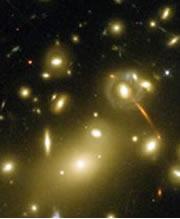 The Universe may have come in countless different versions.© NASA
The Universe may have come in countless different versions.© NASAHow did the Universe begin? Many scientists would regard this as one of the most profound questions of all. But to Stephen Hawking, who has perhaps come closer than anyone to answering it, the question doesn't in fact even exist.
Hawking, based at the University of Cambridge, UK, and his colleague Thomas Hertog of the European Laboratory for Particle Physics at CERN in Geneva, Switzerland, are about to publish a paper claiming that the Universe had no unique beginning1. Instead, they argue, it began in just about every way imaginable (and maybe some that aren't).
Out of this profusion of beginnings, the vast majority withered away without leaving any real imprint on the Universe we know today. Only a tiny fraction of them blended to make the current cosmos, Hawking and Hertog claim.
That, they insist, is the only possible conclusion if we are to take quantum physics seriously. "Quantum mechanics forbids a single history," says Hertog.
“Quantum mechanics forbids a single history.”
Thomas Hertog
CERN, Geneva
The researchers' theory comes in response to a problem raised by 'string theory', one of the best hopes for a theory of everything. String theory permits innumerable different kinds of universe, most of them very different from the one we inhabit. Some physicists suspect that an unknown factor will turn up that rules out most of these universes.
But Hawking and Hertog say that the countless 'alternative worlds' of string theory may actually have existed. We should picture the Universe in the first instants of the Big Bang as a superposition of all these possibilities, they say; like a projection of billions of movies played on top of one another.
It all adds up
This might sound odd, but it is precisely the view adopted by quantum theory. Think of a particle of light reaching our eye from a lamp. Common sense suggests that it simply travels in a straight line from the bulb to the eye. But to make correct predictions about the particle's behaviour, quantum mechanics must consider all other possible paths too, including ones in which, say, the photon bounces around the walls thousands of times before reaching us.
This summation of all paths, proposed in the 1960s by physicist Richard Feynman and others, is the only way to explain some of the bizarre properties of quantum particles, such as their apparent ability to be in two places at once. The key point is that not all paths contribute equally to the photon's behaviour: the straight-line trajectory dominates over the indirect ones.
Hertog argues that the same must be true of the path through time that took the Universe into its current state. We must regard it as a sum over all possible histories.
Take it from the top
He and Hawking call their theory 'top-down' cosmology, because instead of looking for some fundamental set of initial physical laws under which our Universe unfolded, it starts 'at the top', with what we see today, and works backwards to see what the initial set of possibilities might have been. In effect, says Hertog, the present 'selects' the past.
Within just a few seconds after the Big Bang, a single history had already come to dominate the Universe, he explains. So from the 'classical' viewpoint of big objects such as stars and galaxies, things happened only one way after that point. Other 'histories', say, one in which the Earth formed only 4,000 years ago, have made no significant contribution to this cosmic evolution.
But in the first instants of the Big Bang, there existed a superposition of ever more different versions of the Universe, instead of a unique history. And most crucially, Hertog says that "our current Universe has features frozen in from this early quantum mixture".
In other words, some of these alternative histories have left their imprint behind. This is why Hertog and Hawking insist that their 'top-down' cosmology is testable. Hertog says that the theory predicts the pattern of the variations in intensity of microwave background radiation, the afterglow of the Big Bang now imprinted on the sky, which reveal fluctuations in the fireball of the nascent Universe. These variations are minute, but space-based detectors have measured them ever more accurately over the past several years.
As the two researchers work out top-down cosmology in more detail, they hope to be able to calculate the spectrum of these microwave fluctuations and compare it with observations.
The theory also suggests an answer to the puzzle of why some of the 'constants of nature' seem finely tuned to a value that allows life to evolve. If we start from where we are now, it is obvious that the current Universe must 'select' those histories that lead to these conditions. Otherwise we simply wouldn't be here.
